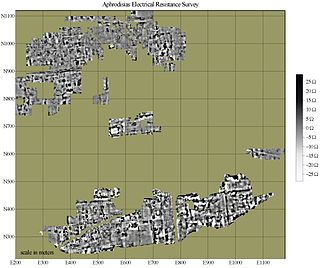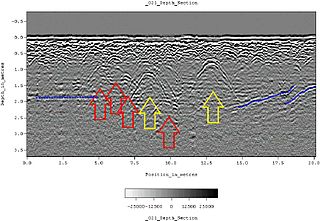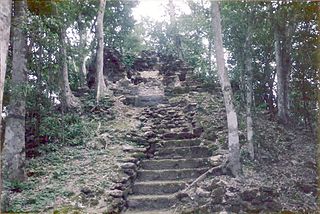Related Research Articles

An archaeological site is a place in which evidence of past activity is preserved, and which has been, or may be, investigated using the discipline of archaeology and represents a part of the archaeological record. Sites may range from those with few or no remains visible above ground, to buildings and other structures still in use.

In archaeology, geophysical survey is ground-based physical sensing techniques used for archaeological imaging or mapping. Remote sensing and marine surveys are also used in archaeology, but are generally considered separate disciplines. Other terms, such as "geophysical prospection" and "archaeological geophysics" are generally synonymous.

El Mirador is a large pre-Columbian Maya settlement, located in the north of the modern department of El Petén, Guatemala.
Aerial archaeology is the study of archaeological remains by examining them from altitude.
Environmental archaeology is a sub-field of archaeology which emerged in 1970s and is the science of reconstructing the relationships between past societies and the environments they lived in. The field represents an archaeological-palaeoecological approach to studying the palaeoenvironment through the methods of human palaeoecology. Reconstructing past environments and past peoples' relationships and interactions with the landscapes they inhabited provides archaeologists with insights into the origin and evolution of anthropogenic environments, and prehistoric adaptations and economic practices.

Ground-penetrating radar (GPR) is a geophysical method that uses radar pulses to image the subsurface. It is a non-intrusive method of surveying the sub-surface to investigate underground utilities such as concrete, asphalt, metals, pipes, cables or masonry. This nondestructive method uses electromagnetic radiation in the microwave band of the radio spectrum, and detects the reflected signals from subsurface structures. GPR can have applications in a variety of media, including rock, soil, ice, fresh water, pavements and structures. In the right conditions, practitioners can use GPR to detect subsurface objects, changes in material properties, and voids and cracks.

In archaeology, survey or field survey is a type of field research by which archaeologists search for archaeological sites and collect information about the location, distribution and organization of past human cultures across a large area. Archaeologists conduct surveys to search for particular archaeological sites or kinds of sites, to detect patterns in the distribution of material culture over regions, to make generalizations or test hypotheses about past cultures, and to assess the risks that development projects will have adverse impacts on archaeological heritage. The surveys may be: (a) intrusive or non-intrusive, depending on the needs of the survey team and; (b) extensive or intensive, depending on the types of research questions being asked of the landscape in question. Surveys can be a practical way to decide whether or not to carry out an excavation, but may also be ends in themselves, as they produce important information about past human activities in a regional context.

In archaeology, an enclosure is one of the most common types of archaeological site – It is any area of land separated from surrounding land by earthworks, walls or fencing. Such a simple feature is found all over the world and during almost all archaeological periods. They may be few metres across or be large enough to encompass whole cities.

Nakbe is one of the largest early Maya archaeological sites. Nakbe is located in the Mirador Basin, in the Petén region of Guatemala, approximately 13 kilometers south of the largest Maya city of El Mirador. Excavations at Nakbe suggest that habitation began at the site during the Early Formative period and continued to be a large site until its collapse during the Terminal Formative period. The fall of Nakbe and El Mirador took place at roughly the same time.

Kinal is a major pre-Columbian Maya archaeological site in the Petén Department of the modern-day Petén Department of northern Guatemala. The major occupational phase for the site dates from the Late Classic period of Mesoamerican chronology, with evidence for a substantial and expansionary building program dating from the first half of the 8th century AD. Kinal was discovered in the 1960s by archaeologist Ian Graham while he was carrying out an archaeological survey of the region, although no excavations were undertaken at the site at that time.
Dr. Thomas L. Sever is an archaeologist with NASA's Marshall Space Flight Center. Dr. Sever is NASA's only archaeologist and works primarily with Dan Irwin to decode remote sensing readings. While most of his work has dealt with South American and ancient Mayan civilization, Dr. Sever has also used his skills in meteorology.

Sarah Helen Parcak is an American archaeologist and Egyptologist, who has used satellite imaging to identify potential archaeological sites in Egypt, Rome, and elsewhere in the former Roman Empire. She is a professor of Anthropology and director of the Laboratory for Global Observation at the University of Alabama at Birmingham. In partnership with her husband, Greg Mumford, she directs survey and excavation projects in the Faiyum, Sinai, and Egypt's East Delta.
William Andrew "Bill" Saturno is an American archaeologist and Mayanist scholar who has made significant contributions toward the study of the pre-Columbian Maya civilization. As of February 2015, Saturno holds a position as assistant professor in archaeology at Boston University's (BU's) College of Arts and Sciences (CAS). He is also the director of the Proyecto San Bartolo-Xultun at the Instito de Antropologia e Historia in Guatemala, a national space research scientist at the Marshall Space Flight Center, as well as a research associate at the Peabody Museum at Harvard University. Prior to his position at BU, Saturno was a lecturer at the University of New Hampshire.

Archaeology or archeology is the scientific study of human activity through the recovery and analysis of material culture. The archaeological record consists of artifacts, architecture, biofacts or ecofacts, sites, and cultural landscapes. Archaeology can be considered both a social science and a branch of the humanities. In Europe it is often viewed as either a discipline in its own right or a sub-field of other disciplines, while in North America archaeology is a sub-field of anthropology.

El Tintal is a Maya archaeological site in the northern Petén region of Guatemala, about 25 kilometres (16 mi) northeast of the modern-day settlement of Carmelita, with settlement dating to the Preclassic and Classic periods. It is close to the better known sites of El Mirador, to which it was linked by causeway, and Nakbé. El Tintal is a sizeable site that includes some very large structures and it is one of the four largest sites in the northern Petén; it is the second largest site in the Mirador Basin, after El Mirador itself. El Tintal features monumental architecture dating to the Middle Preclassic similar to that found at El Mirador, Nakbé and Wakna. Potsherds recovered from the site date to the Late Preclassic and Early Classic periods, and construction continued at the site in the Late Classic period.

Holmul is a pre-Columbian archaeological site of the Maya civilization located in the northeastern Petén Basin region in Guatemala near the modern-day border with Belize.
Diane Zaino Chase is an American anthropologist and archaeologist who specializes in the study of the Ancient Maya.

Arlen F. Chase is a Mesoamerican archaeologist and a faculty member in the anthropology department at Pomona College, Claremont CA. Previously, he was a professor at the University of Nevada, Las Vegas and served a variety of administrative roles at the University of Central Florida over the course of his 32 year stay at that institution. He is noted for his long-term research at the ancient Maya city of Caracol, Belize and for exploring landscape traces of Maya civilization using lidar.
Anabel Ford is an American archaeologist specializing in the study of Mesoamerica, with a focus on the lowland Maya of Belize and Guatemala. She is recognized for her discovery of the ancient Maya city El Pilar. Ford is currently affiliated with the Institute of Social Behavioral and Economic Research (ISBER) and is the director of the MesoAmerican Research Center (MARC) at the University of California, Santa Barbara.
Point Rosee, previously known as Stormy Point, is a headland near Codroy at the southwest end of the island of Newfoundland, on the Atlantic coast of Canada.
References
- ↑ Rindfuss, Ronald R and Stern, Paul C. Linking Remote Sensing and Social Science: The Need and the New Challenges.People and Pixels: Linking Remote Sensing and Social Science.National Academy Press. Washington D.C.1998. ,
- ↑ "Satellite archaeology". National Geographic. Retrieved 13 February 2014.
- ↑ NOVA Science interview,
- 1 2 NASA archaeology website,
- ↑ Sever, Thomas L.Validating Prehistoric and Current Social Phenomena upon the Landscape of the Peten, Guatemala.People and Pixels: Linking Remote Sensing and Social Science.National Academy Press. Washington D.C.1998.,
- ↑ Pope, Kevin O. and Dahlin, Bruce H.Ancient Maya wetland agriculture: new insights from ecological and remote sensing research.Journal of field archaeology.Vol. 16 p. 87-106. 1989
- ↑ Desmond, Lawrence G. and William A. Sauck.Entering the Maya Underworld: A ground penetrating radar Survey at Chichen Itza, Yucatan, Mexico. Innovation et Technologie au Service de Patrimoine de l'Humanite, Actes du colloque organise par Admitech en collaboration avec l'Unesco, Paris, 24 June 1996, pp. 23-30.
- ↑ Sever, Thomas and L and Irwin, Daniel E.LANDSCAPE ARCHAEOLOGY: Remote-sensing investigation of the ancient Maya in the Peten rainforest of northern Guatemala. Ancient Mesoamerica. Issue 1, vol.14. January 2003
- ↑ Chase, A.F.; Chase, D. Z.; Weishampel, J. F.; Drake, J. B.; Shrestha, R. L.; Slatton, K. C.; Awe, J. J. & Carter W. E. (2010). Airborne LiDAR, archaeology, and the ancient Maya landscape at Caracol, Belize. Journal of Archaeological Science. doi : 10.1016/j.jas.2010.09.018
- ↑ "Archaeology Magazine - Lasers in the Jungle - Archaeology Magazine Archive".
- ↑ "Ancient Peru pyramid spotted by satellite". NBC News .
- ↑ Protecting Peru's ancient past https://www.bbc.co.uk/news/world-latin-america-16190824
- ↑ "The Frankincense Route Emerges From the Desert". New York Times. 1992-04-21. Retrieved 2007-12-06.
- ↑ Said-Moorhouse, Lauren. "Space archaeologist unlocks secrets to ancient civilizations". CNN Travel. 20 Sep. 2013. Website. 28 Jan. 2014.http://www.cnn.com/2013/09/02/travel/space-archaeologist-unlocks-secrets/
- ↑ "What is space archaeology?". Sarah Parcak. Website. 28 Jan. 2014. http://www.sarahparcak.com/index2.php#/multi-text_5/1/ Archived 2014-11-03 at the Wayback Machine .
- ↑ "Rome's Lost Empire, BBC One, review". Telegraph. Dec 10, 2012.
- ↑ BBC 4, 31 December 2013, Rome's Lost Empire
